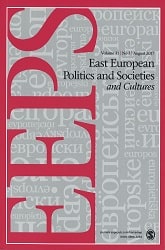Mental Structures in Transition Culture. Differentiating Patterns of Identities and Values in Estonia
Mental Structures in Transition Culture. Differentiating Patterns of Identities and Values in Estonia
Author(s): Triin Vihalemm, Veronika KalmusSubject(s): Political history, Government/Political systems, Politics and society, Culture and social structure , Transformation Period (1990 - 2010), Post-Communist Transformation
Published by: SAGE Publications Ltd
Keywords: Estonia; ethnic groups; generations; mental structures; transition culture;
Summary/Abstract: Based on the concept of transition culture, the article discusses patterns of generational continuity and disruption in post-Soviet Estonia. We suggest a tool for meso-level analysis: factor structures of self-identification and value orientations. The empirical analysis of population survey data collected in 2005 shows that such mental structures have significant correlations with indices of perceptions about social changes and everyday social and cultural practices. Our analysis focuses on mental patterns of three generations among two main ethno-linguistic groups: ethnic Estonians and the Russian minority. The results reveal considerable differentiation between older and younger generations. We suggest that post-Soviet transition has brought about generational disruption in cultural reproduction, which is particularly visible among the ethnic minority group: Russian youngsters differ from their parents to a greater extent than do young Estonians from theirs. Moreover, the mental patterns of young Estonians and Russians have common elements.
Journal: East European Politics and Societies
- Issue Year: 22/2008
- Issue No: 04
- Page Range: 901-927
- Page Count: 27
- Language: English
- Content File-PDF

